
Wake County is located in the U.S. state of North Carolina. In the 2020 census, its population was 1,129,410, making it North Carolina's most-populous county. From July 2005 to July 2006, Wake County was the 9th-fastest growing county in the United States, with Cary and Raleigh being the 8th- and 15th-fastest growing cities, respectively.
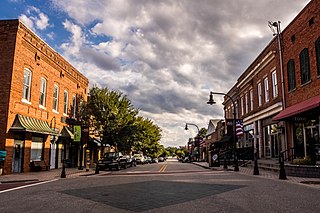
Wake Forest is a town in Franklin, Granville and Wake counties in the U.S. state of North Carolina; located almost entirely in Wake County, it lies just north of the state capital, Raleigh. At the 2020 census, the population was 47,601. That is up from 30,117 in 2010, up from 12,588 in 2000. The U.S. Census Bureau estimates the city's population to be 47,601 as of April 1, 2020. In 2007, the town was listed by Forbes magazine as the 20th fastest growing suburb in America, with a 73.2 percent increase in population between 2000 and 2006. Wake Forest was the original home of Wake Forest University for 122 years before it moved to Winston-Salem in 1956.
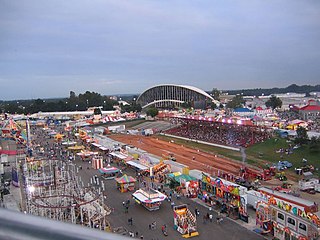

The North Carolina State Capitol is the former seat of the legislature of the U.S. state of North Carolina which housed all of the state's government until 1888. The Supreme Court and State Library moved into a separate building in 1888, and the General Assembly moved into the State Legislative Building in 1963. Today, the governor and his immediate staff occupy offices on the first floor of the Capitol.

J. S. Dorton Arena is a 7,610-seat multi-purpose arena located in Raleigh, North Carolina, on the grounds of the North Carolina State Fair. It opened in 1952.

The North Carolina Executive Mansion is the official residence of the governor of North Carolina and their family. Building began in the year 1883 and it was designed by architects Samuel Sloan and A.G. Bauer. The first occupants, Governor Daniel G. Fowle and his daughter, Helen Whitaker Fowle, moved into the unfinished building in January 1891. It is an example of Queen Anne style architecture.

Christ Church refers to both an Episcopal parish currently located in Matapeake, Maryland and the historic church building located in the Stevensville Historic District in Stevensville, Maryland, which the parish occupied from 1880 to 1995, and that is now a Lutheran church. Christ Church Parish was one of the original 30 Anglican parishes in the Province of Maryland.

Christ Episcopal Church, also known as Christ Church on Capitol Square, is an Episcopal church at 120 East Edenton Street in Raleigh, North Carolina. Built in 1848–53 to a design by Richard Upjohn, it is one of the first Gothic Revival churches in the American South. The church was built for a parish established in 1821; its minister is the Rev. James P. Adams. It was declared a National Historic Landmark in 1987.
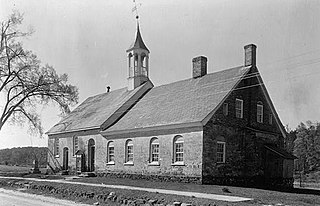
Bethabara Historic District encompasses the surviving buildings and archaeological remains of a small Moravian community, that was first settled in 1753. Located in present-day Forsyth County, North Carolina, it is now a public park of the city of Winston-Salem. It was designated National Historic Landmark in 1999.

The Capitol Area Historic District is a national historic district located at Raleigh, North Carolina. The district encompasses 25 contributing buildings and was developed after 1792. The district includes notable examples of Classical Revival and Late Gothic Revival style architecture. Located in the district are the following separately listed buildings:

The Masonic Temple Building located at 133 Fayetteville Street in Raleigh, North Carolina was the state's first reinforced concrete skyscraper. Constructed in 1907 by Grand Lodge of North Carolina, the building represents the growth of Raleigh in the early 20th century and rise of the influence of Masons. The Masonic Temple Building was added to the National Register of Historic Places in 1979 and is a Raleigh Historic Landmark.

The Federal Building, also known as the Century Post Office, is a historic building located on Fayetteville Street in Raleigh, Wake County, North Carolina, United States. It was the first Federal Government project in the South following the Civil War. Construction of the building began in 1874 and was completed in 1878. The building's Second Empire design was by Alfred B. Mullett whose more famous works included the Old Executive Office Building located near the White House. The Federal Building was listed on the National Register of Historic Places in 1971 and is a Raleigh Historic Landmark.
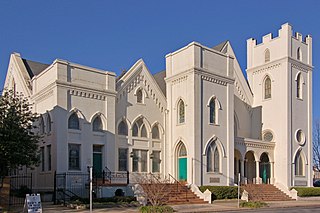
The Long View Center is a historic church building located in the Moore Square Historic District of Raleigh, North Carolina, United States. The facility sits directly across from Moore Square, one of two surviving four-acre parks from Raleigh's original 1792 plan. Built between 1879 and 1881, Long View was originally known as Tabernacle Baptist Church. The name of the building was changed to Long View Center in 1998 after a local developer purchased the property to be used as a mixed-use facility. After a purchase in December 2013, it is now owned by Vintage Church. Currently, the sanctuary and offices are used by Vintage Church and Sunday services are held by Vintage Church Downtown.

The North Carolina School for the Deaf (NCSD) is a state-supported residential school for deaf children established in 1894, in Morganton, North Carolina, US.
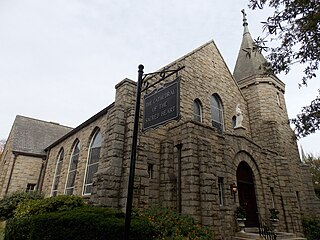
Sacred Heart Church is a Catholic church located on Hillsborough Street in downtown Raleigh, North Carolina, United States. The church served as the cathedral of the Diocese of Raleigh from 1924 to 2017. In 1978 it, and the other parish buildings, was included as a contributing property in the Capitol Area Historic District, which is listed on the National Register of Historic Places. Sacred Heart is also the location of the Cathedral School, formally called Sacred Heart Cathedral School.

St. John's Episcopal Church is a historic Episcopal church located on SR 1329 in Williamsboro, Vance County, North Carolina. It was built in 1773, and is a rectangular, seven bay long, frame church on a brick foundation. It has a gable roof and is sheathed in weatherboard. The church was restored in the 1950s.
Hobart Brown Upjohn (1876–1949) was an American architect, best known for designing a number of ecclesiastical and educational structures in New York and in North Carolina. He also designed a number of significant private homes. His firm produced a total of about 150 projects, a third of which were in North Carolina.
The following is a timeline of the history of the city of Raleigh, North Carolina, USA.

Elizabeth City Historic District is a national historic district located at Elizabeth City, Pasquotank County, North Carolina. The district encompasses 592 contributing buildings, 1 contributing site, 1 contributing structure, and 1 contributing object in the central business district and surrounds residential sections of Elizabeth City. The district developed after 1789, and includes representative examples of Greek Revival, Federal, and Late Victorian style architecture. Notable contributing buildings include the Grice-Fearing House (1789-1808), Shirley Armstrong House, Goodman-Matthews-Pool House, Dr. William Martin House, Pool-Kennedy-Lumsden House, Charles-Hussey House, Richardson-Pool House, North Carolina Building (1859), Cobb Building, the former First Methodist Church, Christ Episcopal Church (1857), J. W. Dent House, Dr. Butt's Drug Store, the McMullen Building, the Lowrey Building, former Citizens Bank, Robinson Building (1903), Kramer Building (1909), Selig Building (1925), the Virginia Dare Hotel and Arcade (1927), First Baptist Church (1889), United States Post Office and Courthouse, and Pasquotank County Courthouse (1882).

White-Holman House is a historic home located at Raleigh, Wake County, North Carolina. It was built about 1798, and is a two-story, three bay, frame dwelling with a two-story wing and one-story rear shed addition. It is sheathed in weatherboard and has a side-hall plan. It was built by William White (1762–1811), North Carolina Secretary of State, 1798–1811. The house was moved to its present location in April 1986.






















